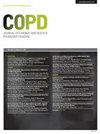Network Pharmacology Followed by Experimental Validation to Explore the Mechanism of Stigmasterol in Sangbaipi Decoction Regulating PI3K/Akt Signaling to Alleviate Acute Exacerbation of Chronic Obstructive Pulmonary Disease
IF 3.1
3区 医学
Q1 Medicine
International Journal of Chronic Obstructive Pulmonary Disease
Pub Date : 2024-08-08
DOI:10.2147/copd.s459814
引用次数: 0
Abstract
Purpose: Sangbaipi decoction (SBPD), a traditional Chinese medicine (TCM) prescription, has been widely used to treat acute exacerbation of chronic obstructive pulmonary disease (AECOPD), while the underlying pharmacological mechanism remains unclear due to the complexity of composition.Methods: A TCM-active ingredient-drug target network of SBPD was constructed utilizing the TCM-Systems-Pharmacology database. AECOPD-relevant proteins were gathered from Gene Cards and the Online-Mendelian-Inheritance-in-Man database. Protein–protein interaction, GO and KEGG enrichment analyses of the targets from the intersection of SBPD and AECOPD targets were performed to identify the core signaling pathway, followed by molecular docking verification of its interaction with active ingredients. The network pharmacology results were checked using in-vivo experiments. To induce AECOPD, rats were exposure to combined tobacco smoke and lipopolysaccharide (LPS). Then rats underwent gavage with stigmasterol (SM) after successful modeling. The involvement of phosphoinositide 3-kinase (PI3K)/protein kinase B (Akt) signaling was investigated using its inhibitor, LY294002. Lung function and histopathology were examined. The levels of inflammatory cytokines in the lung and serum were assessed by quantitative reverse transcription-polymerase chain reaction (qRT-PCR), Western blot and/or Enzyme-linked immunosorbent assay (ELISA).
Results: SM was recognized as an active ingredient of SBPD and stably bound to Akt1. SM improved lung function and histological abnormalities, concomitant with suppressed PI3K/Akt signaling, downregulated lung and serum Interleukin 6 (IL-6) and tumor necrosis factor-α (TNF-α) levels and serum transforming growth factor-β (TGF-β) levels and upregulated lung and serum Interleukin 10 (IL-10) levels in AECOPD rats. In AECOPD rats, LY294002 restored lung function, and it also improved lung histological abnormalities and inflammation, which was found to be potentiated by SM.
Conclusion: SM targets PI3K/Akt signaling to reduce lung injury and inflammation in AECOPD rats.
Keywords: sangbaipi decoction, stigmasterol, acute exacerbation of chronic obstructive pulmonary disease, PI3K/Akt signaling, lung inflammation
通过实验验证网络药理学,探索桑白皮煎剂中的麦角甾醇调节 PI3K/Akt 信号以缓解慢性阻塞性肺病急性加重的机制
目的:桑白皮水煎剂(SBPD)是一种中药处方,被广泛用于治疗慢性阻塞性肺疾病急性加重期(AECOPD),但由于其成分复杂,其潜在的药理机制仍不清楚:方法:利用中药系统药理学数据库构建了SBPD的中药活性成分-药物靶点网络。方法:利用中药系统药理学数据库构建了中药活性成分-药物靶点网络。对 SBPD 和 AECOPD 目标交叉点的目标进行蛋白质-蛋白质相互作用、GO 和 KEGG 富集分析,以确定核心信号通路,然后对其与活性成分的相互作用进行分子对接验证。利用体内实验检验了网络药理学结果。为了诱导 AECOPD,大鼠暴露于烟草烟雾和脂多糖(LPS)的联合作用下。建模成功后,给大鼠灌胃豆固醇(SM)。研究人员使用磷酸肌醇3-激酶(PI3K)/蛋白激酶B(Akt)信号转导抑制剂LY294002对其进行了研究。对肺功能和组织病理学进行了检查。通过定量逆转录聚合酶链反应(qRT-PCR)、Western 印迹和/或酶联免疫吸附试验(ELISA)评估了肺部和血清中的炎症细胞因子水平:结果:SM被认为是SBPD的活性成分,并与Akt1稳定结合。SM改善了AECOPD大鼠的肺功能和组织学异常,同时抑制了PI3K/Akt信号传导,下调了肺和血清白细胞介素6(IL-6)和肿瘤坏死因子-α(TNF-α)水平以及血清转化生长因子-β(TGF-β)水平,上调了肺和血清白细胞介素10(IL-10)水平。在 AECOPD 大鼠中,LY294002 能恢复肺功能,还能改善肺组织学异常和炎症,而 SM 能增强这种作用:关键词:桑白皮水煎剂;豆甾醇;慢性阻塞性肺疾病急性加重;PI3K/Akt信号转导;肺部炎症
本文章由计算机程序翻译,如有差异,请以英文原文为准。
求助全文
约1分钟内获得全文
求助全文
来源期刊

International Journal of Chronic Obstructive Pulmonary Disease
RESPIRATORY SYSTEM-
CiteScore
5.10
自引率
10.70%
发文量
372
审稿时长
16 weeks
期刊介绍:
An international, peer-reviewed journal of therapeutics and pharmacology focusing on concise rapid reporting of clinical studies and reviews in COPD. Special focus will be given to the pathophysiological processes underlying the disease, intervention programs, patient focused education, and self management protocols. This journal is directed at specialists and healthcare professionals
 求助内容:
求助内容: 应助结果提醒方式:
应助结果提醒方式:


